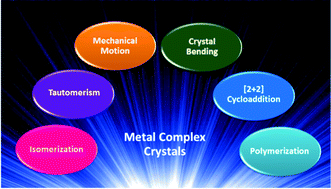Photochemical reactions of metal complexes in the solid state
Abstract
This perspective focusses on the solid-state reactivity and structural transformation driven by photochemical methods in discrete metal complexes, organometallic compounds, metallo-macrocycles and cages. Changes in the metal–metal bond distances, racemization of chiral centres, fusion of cages, formation of coordination polymers, expected [2 + 2] and [4 + 4] cycloaddition products, unusual phenyl-olefin dimerization, and linkage isomerization of –SO2, –NO & –NO2 ligands cause the structural transformations. Of these, [2 + 2] photo-cycloaddition reactions have been widely studied and the photoreactions are made possible by various supramolecular interactions including hydrogen bonds, metallophilic, π⋯π and C–H⋯π interactions, ligand design and metallic clips to bring the reactive functional groups closely into correct orientation close to the transition state. These photoreactions are often accompanied by crystal bending, mechanical motion, and changes in the magnetic and photoluminescence properties. In several cases, the single crystals have been preserved at the end of the reactions, which are known as single-crystal-to-single-crystal (SCSC) reactions.

- This article is part of the themed collection: 2017 Frontier and Perspective articles


 Please wait while we load your content...
Please wait while we load your content...